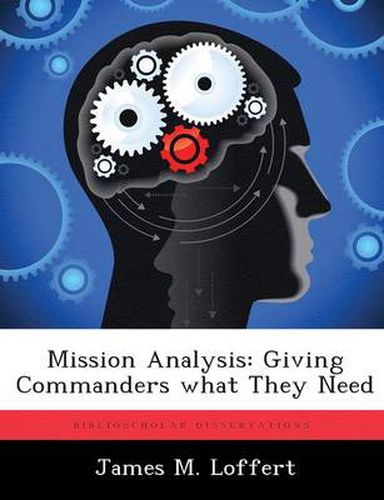Readings Newsletter
Become a Readings Member to make your shopping experience even easier.
Sign in or sign up for free!
You’re not far away from qualifying for FREE standard shipping within Australia
You’ve qualified for FREE standard shipping within Australia
The cart is loading…






This title is printed to order. This book may have been self-published. If so, we cannot guarantee the quality of the content. In the main most books will have gone through the editing process however some may not. We therefore suggest that you be aware of this before ordering this book. If in doubt check either the author or publisher’s details as we are unable to accept any returns unless they are faulty. Please contact us if you have any questions.
The purpose of this monograph is to answer the research question: does the current process for executing mission analysis give commanders the information they need to develop timely, relevant, and constructive commander’s intent and commander’s guidance. This paper focused on the first two aspects of battle command: visualization and description. There are problems with the doctrinal mission analysis process that hinders commanders and their staffs in visualizing and describing an operation. The over-arching problem occurring during execution of the current mission analysis process is that staffs are not giving commanders what they need to complete their required deliverables at the conclusion of the mission analysis brief: timely, relevant, and constructive initial commander’s intent and commander’s planning guidance. In its current form, the mission analysis process fails to address three fundamental problems during the execution of mission analysis. First, it does not take into account the lack of sufficient relevant experience of most staff members to intuitively see the relevant conclusions from the information gathered by the process. Second, it does not adequately describe the complex nature of the commander and staff relationship and how the staff uses each step of the mission analysis process to assist the commander. Lastly, the mission analysis process does not assist staffs to present the information gathered from the process in a manner that properly frames the problem and relates proper context to the commander in order to facilitate the development of his intent and guidance. Although solving the problem of inexperience is beyond the scope of this paper, the proposal does recommend several methods commanders and staffs can use to mitigate for lack of relevant experience. As for the other two problems, the mission analysis construct is good, but not complete. The current doctrine for mission analysis is incomplete in four areas: it fails to fully conve
$9.00 standard shipping within Australia
FREE standard shipping within Australia for orders over $100.00
Express & International shipping calculated at checkout
This title is printed to order. This book may have been self-published. If so, we cannot guarantee the quality of the content. In the main most books will have gone through the editing process however some may not. We therefore suggest that you be aware of this before ordering this book. If in doubt check either the author or publisher’s details as we are unable to accept any returns unless they are faulty. Please contact us if you have any questions.
The purpose of this monograph is to answer the research question: does the current process for executing mission analysis give commanders the information they need to develop timely, relevant, and constructive commander’s intent and commander’s guidance. This paper focused on the first two aspects of battle command: visualization and description. There are problems with the doctrinal mission analysis process that hinders commanders and their staffs in visualizing and describing an operation. The over-arching problem occurring during execution of the current mission analysis process is that staffs are not giving commanders what they need to complete their required deliverables at the conclusion of the mission analysis brief: timely, relevant, and constructive initial commander’s intent and commander’s planning guidance. In its current form, the mission analysis process fails to address three fundamental problems during the execution of mission analysis. First, it does not take into account the lack of sufficient relevant experience of most staff members to intuitively see the relevant conclusions from the information gathered by the process. Second, it does not adequately describe the complex nature of the commander and staff relationship and how the staff uses each step of the mission analysis process to assist the commander. Lastly, the mission analysis process does not assist staffs to present the information gathered from the process in a manner that properly frames the problem and relates proper context to the commander in order to facilitate the development of his intent and guidance. Although solving the problem of inexperience is beyond the scope of this paper, the proposal does recommend several methods commanders and staffs can use to mitigate for lack of relevant experience. As for the other two problems, the mission analysis construct is good, but not complete. The current doctrine for mission analysis is incomplete in four areas: it fails to fully conve